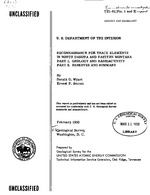Reconnaissance for trace elements in North Dakota and eastern Montana. Part 1. Geology and radioactivity. Part 2. Reserves and summary
Links
- Document: Report (pdf)
- Plates:
- Download citation as: RIS | Dublin Core
Abstract
A reconnaissance for sources of radioactive material in North Dakota and eastern Montana was made in 1948. This reconnaissance was followed by a more detailed survey of parts of Golden Valley and Slope counties, southwestern North Dakota, in June 1949.
The radioactivity of representative sections of all formations known to be exposed in the area and of three manganiferous spring deposits was determined with portable Geiger-Mueller counters. At 86 localities 82 samples were taken of these formations and also of 10 ground and surface waters.
Only the lignites in the upper part of the Sentinel Butte member of the Fort Union formation in the southwestern part of N. Dak. contained more than 0.005 per cent equivalent to U3O8 . The ground and surface waters tested were for the most part non-radioactive. Water sample number 291 from locality 100, however, contained 0.17 parts per million U3O8.
The radioactive lignites of N. Dak. appear to be limited to the higher buttes, such as Sentinel, Flat Top (Square Top), Bullion, H-T(Black), and White(Chalky) Buttes. One to five lignite beds are found in a 90-foot stratigraphic interval near the top of the Sentinel Butte member of the Fort Union formation, and from about 40 to 140 feet beneath the base of the overlying White River formation. The thickness of the beds ranges from a few inches to over six feet. The nomenclature, and therefore correct correlation, of all the beds above the middle part of the Sentinel Butte member is in doubt. The lignites and associated sand and clay beds are believed to be either equivalent to, or close to the base of, the Eocene Golden Valley formation.
The exact mode of origin of the uranium in the lignite is not known. Uranium may have accumulated in swamps at the same time as the organic debris, or it may have been introduced by ground water after the formation of lignite. In either case carbon or carbon compounds apparently caused the precipitation or fixation of uranium. Further work is needed to determine the origin of this type of uranium deposit.
Study Area
| Publication type | Report |
|---|---|
| Publication Subtype | USGS Numbered Series |
| Title | Reconnaissance for trace elements in North Dakota and eastern Montana. Part 1. Geology and radioactivity. Part 2. Reserves and summary |
| Series title | Trace Elements Investigations |
| Series number | 61 |
| DOI | 10.3133/tei61 |
| Year Published | 1950 |
| Language | English |
| Publisher | U.S. Geological Survey |
| Description | Report: 29 p.; 3 Plates: 21.80 x 16.32 inches or smaller |
| Country | United States |
| State | Montana, North Dakota |
| Online Only (Y/N) | N |
| Additional Online Files (Y/N) | N |


